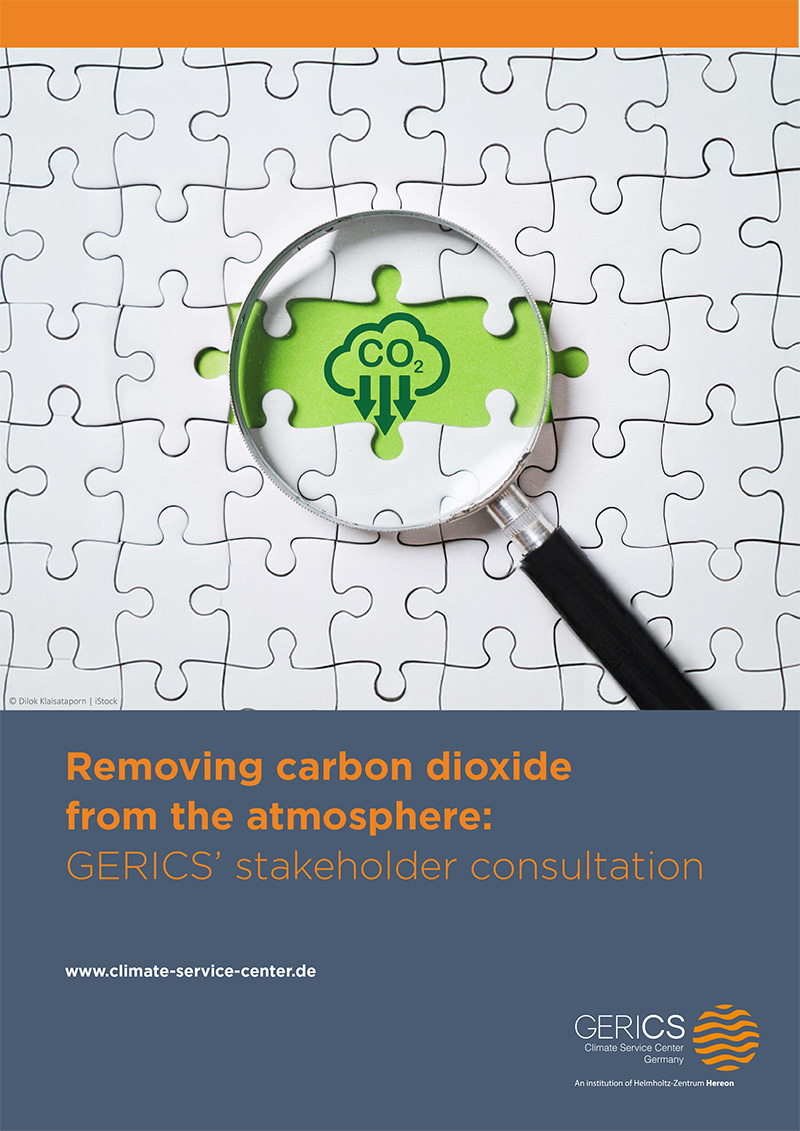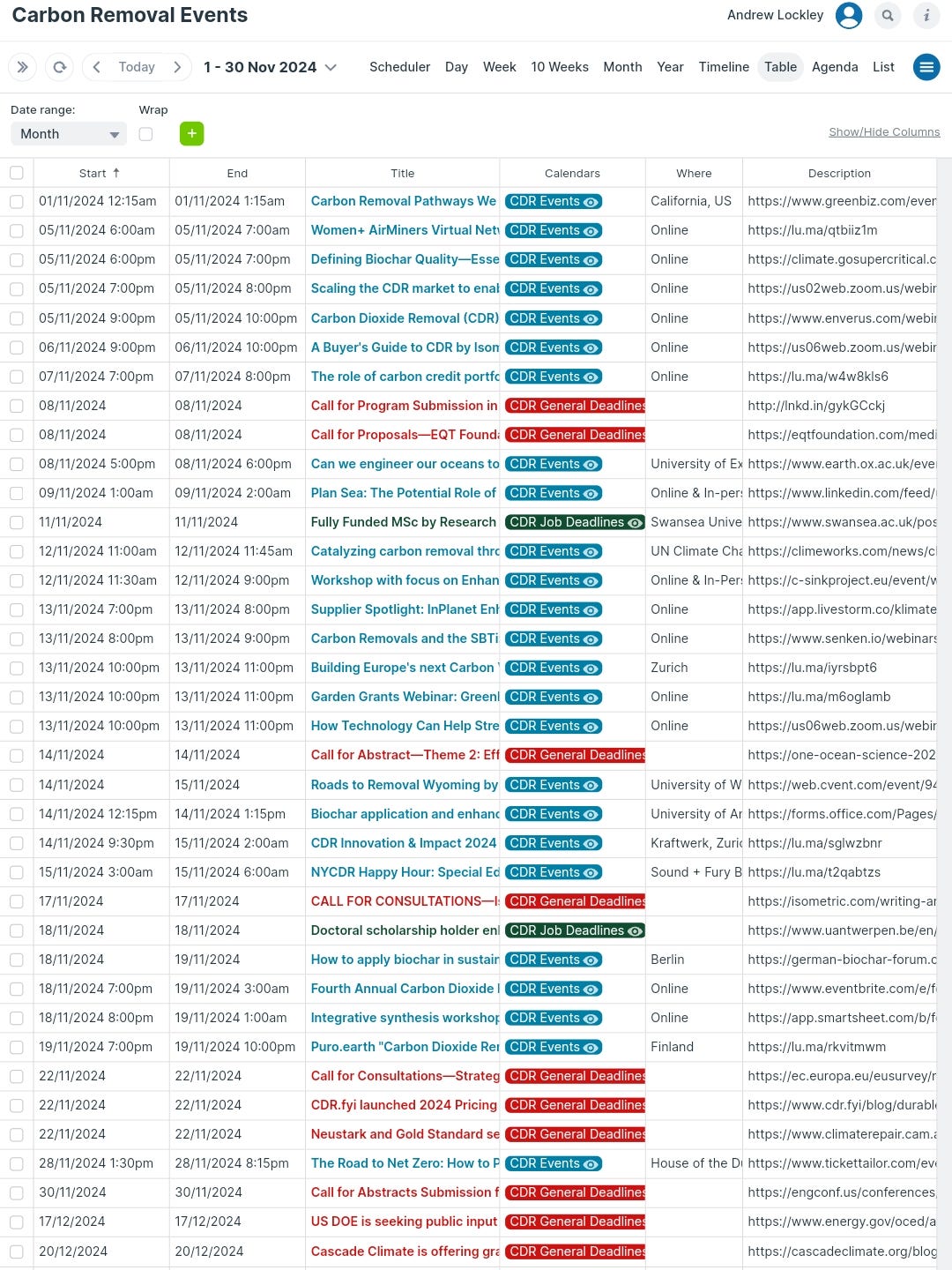CARBON REMOVAL WEEKLY SUMMARY (28 OCTOBER - 03 NOVEMBER 2024)—WEEK#44
Links to recent scientific papers, web posts, upcoming events, job opportunities, podcasts, and event recordings, etc. on Carbon Dioxide Removal Technology.
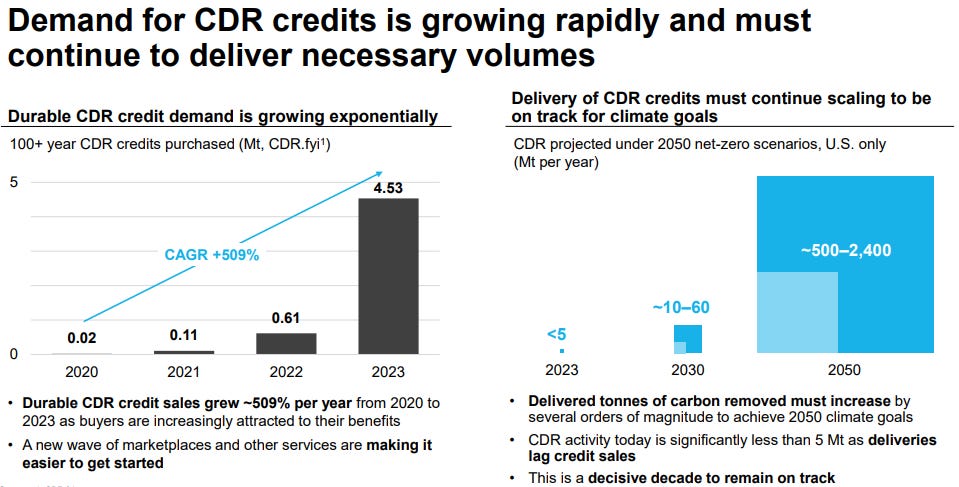
TABLE OF CONTENTS
1. Commercial News
2. Research Papers
3. Web Posts
4. Reports
5. Book
6. Upcoming Events
7. Job Opportunities
8. Podcasts
9. YouTube Videos
10. Deadlines
Note: Click on the headings listed in the table of contents above to easily navigate to the sections you're interested in.
COMMERCIAL NEWS
Myno awarded $20.4 million USDA fertilizer expansion grant (Mynocarbon)
Treehouse Almonds to build $9 million biochar facility in Delano (The Sun)
CREW Carbon raised $5.3M to capture CO2 at wastewater treatment plants (PR Newswire)
Truecoco Ghana secured $3.3M from BII for a CDR project to capture 250k MT CO2 and aid 30k farmers (CNR)
Homeworld Collective launched its second round of Garden Grants, offering up to $1M for scalable GHG removal projects (Homeworld Bio)
Climeworks proposed $50 Million investment to expand its Louisiana’s direct air capture hub into Southwest Louisiana (LED)
Adaptavate secured a £1M Innovate UK grant to advance its carbon-negative plasterboard (Made in Britain)
Nordbex Launches Ambitious BECCS Operations In Sweden (Carbon Herald)
Spiritus announced to open a Missouri facility to produce novel sorbents for direct air capture (Business Wire)
1PointFive partnered with Enterprise Products to build a CO2 transport network for Texas’s Bluebonnet Sequestration Hub (Morning Star)
CDR firm Travertine partnered with Sabin Metal to set up a demo plant in Scottsville, NY (World Fertlizer Magazine)
INNOVX and NetZero partnered to accelerate biochar deployment across Global South (Morocco World News)
Blusky Carbon and Scotia BioChar partnered to deploy biochar pyrolysis equipment in Nova Scotia, using waste wood biomass for carbon removal (Biochar Today)
Origen partnered with EERC to speed up DAC tech commercialization (Carbon Herald)
Aviva Investors launches carbon removal fund (Funds Europe)
BluSky Carbon commenced biochar production in Arkansas (MorningStar)
RESEARCH PAPERS
Fast recovery of North Atlantic sea level in response to atmospheric carbon dioxide removal
Oh, J. H., Wang, S., Shin, Y., & Kug, J. S. (2024). Fast recovery of North Atlantic sea level in response to atmospheric CO2 removal.
Synopsis: Sea level rise from human-driven warming endangers coasts, yet its reversibility varies by region. Researchers examine the Subpolar North Atlantic, showing rapid sea level rise during CO₂ increase and a sharper decline with CO₂ removal. This fluctuation stems from changes in the Atlantic Meridional Overturning Circulation. Findings suggest substantial sea level shifts in the region are possible under climate mitigation efforts.
Exploring small-scale direct air capture in a building ventilation system: a case study in Linköping, Sweden
Milić, V., Larsson Ståhl, A., Granli, A., & Moshfegh, B. (2024). Exploring small-scale direct air capture in a building ventilation system: a case study in Linköping, Sweden. Frontiers in Energy Research, 12, 1443974.
Synopsis: This study assesses the feasibility of Direct Air Capture (DAC) in gym ventilation systems to reduce CO₂. Testing in a Linköping, Sweden gym, results show CO₂ capture of 54–83 kg/day per gym and 588–750 tons/year across multiple gyms. Regenerating sorbents after hours proved more energy- and cost-effective. Economic viability is achieved with a sorbent capture potential of 2.0 mmol/g and low-grade heat use, costing 663 SEK/ton CO₂. Findings support DAC’s potential in carbon-negative building designs with energy-efficient integration.
Demographics shape public preferences for carbon dioxide removal and solar geoengineering interventions across 30 countries
Sovacool, B. K., Evensen, D., Baum, C. M., Fritz, L., & Low, S. (2024). Demographics shape public preferences for carbon dioxide removal and solar geoengineering interventions across 30 countries. Communications Earth & Environment, 5(1), 642.
Synopsis: This study investigates public preferences for 10 climate intervention technologies through surveys in 30 countries, focusing on demographics like gender, age, income, and poverty. Findings reveal that support for engineered carbon removal declines with age, while gender has minimal impact. People in poverty and those in the Global South show stronger support for various interventions. Results highlight demographic influences on public acceptance, with vulnerability factors shaping support for climate technologies.
Growing biomass carbon stock in China driven by expansion and conservation of woody areas
Liao, Z., Yue, C., He, B., Zhao, K., Ciais, P., Alkama, R., ... & Wang, M. (2024). Growing biomass carbon stock in China driven by expansion and conservation of woody areas. Nature Geoscience, 1-8.
Synopsis: The Paris Agreement requires countries to enhance transparency in greenhouse gas inventories. China reports forest carbon gains, but independent satellite-based support has been limited. Using remote sensing from 2001-2020, researchers find a 6.2% forest cover increase and a woody biomass carbon sink of 208.6 TgC/yr, aligning with national inventories. Conservation contributed 59.2% and anthropogenic expansion 29.4% to this sink, with ecological projects playing a key role. This study highlights human management’s impact on China’s carbon balance.
Assessment of the Potential for Carbon Sink Enhancement in the Overlapping Ecological Project areas of China
Xu, X., Jiao, F., Lin, D., Qiu, J., Zou, C., & Zhang, K. Assessment of the Potential for Carbon Sink Enhancement in the Overlapping Ecological Project areas of China. Frontiers in Plant Science, 15, 1482077.
Synopsis: Ecological engineering boosts carbon sequestration, but few studies forecast carbon sink trends in areas with overlapping projects under varying climate and land use scenarios. This study used machine learning to analyze stability and drivers of carbon sinks from 1982-2019. Findings: (1) Carbon sinks rose most in regions with five projects; (2) more projects reduced human impact; (3) western China saw greater sink gains due to climate and afforestation. A combined ecological strategy maximizes sink stability, supporting carbon neutrality goals.
Climate beliefs, climate technologies and transformation pathways: Contextualizing public perceptions in 22 countries
Fritz, L., Baum, C. M., Brutschin, E., Low, S., & Sovacool, B. K. (2024). Climate beliefs, climate technologies and transformation pathways: Contextualizing public perceptions in 22 countries. Global Environmental Change, 87, 102880.
Synopsis: As carbon removal and solar radiation modification gain attention in climate policy, understanding public perception is vital. Using focus groups and a survey across 22 countries, this study found that personal harm from climate change and climate anxiety influence support. Public views reveal tensions, like “buying time vs. delaying action,” and align with three narratives: behavior change, industry-driven, and tech-focused paths. Support depends on these technologies aligning with credible decarbonization and addressing diverse climate concerns.
Optimizing Carbon Dioxide Injection for Methane Hydrate Development and Carbon Sequestration: A Long-Term Numerical Simulation Study
Zhang, Z., Li, Y., Xu, T., Li, S., Li, X., Lu, C., & Qin, X. (2024). Optimizing Carbon Dioxide Injection for Methane Hydrate Development and Carbon Sequestration: A Long-Term Numerical Simulation Study. Energy & Fuels.
Synopsis: This study explores CO₂ injection as a method to boost methane production and enable carbon sequestration in hydrate reservoirs. Simulations over 100,000 years reveal that CO₂ injection increases methane yield in shallow seafloor hydrates, where CO₂ hydrates remain stable after pressure/temperature normalization. Effective replacement relies on shallow depth, intact seals, and precise CO₂ injection rates, avoiding CO₂ breakthrough. Findings aid in feasibility, site selection, and operational strategies for CO₂-based methane hydrate extraction.
Electrochemical regeneration of high-purity CO2 from (bi)carbonates in a porous solid electrolyte reactor for efficient carbon capture
Zhang, X., Fang, Z., Zhu, P., Xia, Y., & Wang, H. (2024). Electrochemical regeneration of high-purity CO2 from (bi) carbonates in a porous solid electrolyte reactor for efficient carbon capture. Nature Energy, 1-11.
Synopsis: Carbon capture processes face high energy demands, particularly during CO₂ and absorbent regeneration. This study presents a one-step electrochemical method for regenerating CO₂ and alkaline absorbent using a modular porous solid electrolyte (PSE) reactor. By facilitating hydrogen evolution and oxidation reactions, the PSE reactor effectively splits NaHCO₃/Na₂CO₃ solutions into NaOH and high-purity CO₂ without chemical consumption or by-product generation. The process shows impressive results: a Na⁺-ion transport number of ~90%, 90% capture capacity retention, low energy consumption (50-118 kJ/mol), and long-term stability (>100 hours), achieving significant regeneration rates of up to 1 A/cm².
Productive in Disagreement: Stakeholder deliberation insights on carbon dioxide removal in Germany
Apergi, M., Hellmich, M., Eberenz, S., Honegger, M., Reinecke, S., & Tänzler, D. Productive in Disagreement: Stakeholder deliberation insights on carbon dioxide removal in Germany. Frontiers in Climate, 6, 1465613.
Synopsis: Growing attention to CDR methods, such as DACCS, necessitates incorporating stakeholder perspectives in climate policy development. This exploratory study examines stakeholder engagement in a transdisciplinary research project focused on CDR policy design and evaluation. Insights from workshops and surveys reveal that participants’ views on DACCS evolved through learning, emphasizing the importance of deployment context. The findings advocate for deliberative, adaptable policymaking that balances climate mitigation with other goals and stress the need for government-backed CDR research and development alongside fossil fuel phaseout to maintain a clear carbon budget.
Seafloor sediment characterization improves estimates of organic carbon standing stocks: an example from the Eastern Shore Islands, Nova Scotia, Canada
Brenan, C., Kienast, M., Maselli, V., Algar, C. K., Misiuk, B., & Brown, C. J. (2024). Seafloor sediment characterization improves estimates of organic carbon standing stocks: an example from the Eastern Shore Islands, Nova Scotia, Canada. Biogeosciences, 21(20), 4569-4586.
Synopsis: This study utilizes high-resolution multibeam echosounder data from the Eastern Shore Islands off Nova Scotia, combined with discrete organic carbon (OC) measurements, to evaluate OC distribution in seafloor sediments. Four spatial models generated varying estimates of OC stocks (80,901 to 6,475 tons) across a 223 km² area, highlighting the importance of high-resolution mapping for identifying carbon hotspots crucial for seabed management and climate mitigation.
Faster dieback of rainforests altering tropical carbon sinks under climate change
Nath, D., Nath, R., & Chen, W. (2024). Faster dieback of rainforests altering tropical carbon sinks under climate change. npj Climate and Atmospheric Science, 7(1), 235.
Synopsis: Tropical rainforests currently act as critical carbon sinks, helping to mitigate global warming. However, deforestation and climate change are pushing some areas toward becoming net carbon sources. Using machine learning, predictions indicate that over 50% of these forests could experience rapid “savannisation” by the end of the 21st century under high emission scenarios. In Central Amazonia, vegetation degradation is expected to saturate carbon sinks, transforming over 25% into net carbon sources due to increased soil microbial respiration. This shift will worsen if temperatures exceed 1.5°C, significantly impacting climate stabilization policies.
Cyanobacteria newly isolated from marine volcanic seeps display rapid sinking and robust, high-density growth
Schubert, M. G., Tang, T. C., Goodchild-Michelman, I. M., Ryon, K. A., Henriksen, J. R., Chavkin, T., ... & Tierney, B. T. (2024). Cyanobacteria newly isolated from marine volcanic seeps display rapid sinking and robust, high-density growth. Applied and Environmental Microbiology, e00841-24.
Synopsis: This study isolates two novel cyanobacteria, UTEX 3221 and UTEX 3222, from a marine environment with high CO₂ levels, detailing their complete genomes. Notably, UTEX 3222 exhibits remarkable growth characteristics, doubling every 2.35 hours in liquid culture and achieving high biomass densities (>31 g/L dry weight) in batch cultures—nearly double that of previously studied strains. Additionally, its ability to sink quickly enhances biomass harvesting efficiency. These traits position UTEX 3222 as a promising candidate for marine carbon dioxide removal and photosynthetic bioproduction, highlighting the potential of bio-prospecting in CO₂-rich environments to discover unique organisms.
Permafrost Region Greenhouse Gas Budgets Suggest a Weak CO2 Sink and CH4 and N2O Sources, But Magnitudes Differ Between Top-Down and Bottom-Up Methods
Hugelius, G., Ramage, J., Burke, E., Chatterjee, A., Smallman, T. L., Aalto, T., ... & Zheng, B. (2024). Permafrost region greenhouse gas budgets suggest a weak CO2 sink and CH4 and N2O sources, but magnitudes differ between top‐down and bottom‐up methods. Global Biogeochemical Cycles, 38(10), e2023GB007969.
Synopsis: Northern permafrost soils contain significant stocks of carbon and nitrogen, which are at risk of release due to climate change, leading to uncertainties in GHG budgets. This study compares bottom-up (data-driven and process-based models) and top-down (atmospheric inversion models) estimates of CO2, CH4, and N2O emissions from 2000 to 2020. Both approaches indicate a CO2 sink in natural ecosystems, while CH4 and N2O are sources. Although the combined global warming potential over 100 years appears neutral, the region acts as a net GHG source over 20 years due to CH4 emissions. Recommendations for future research include improving inland water modeling and enhancing GHG measurement techniques to resolve discrepancies between estimation methods.
Understory plant biodiversity is inversely related to carbon storage in a high carbon ecosystem
Carter, T. A., & Buma, B. (2024). Understory plant biodiversity is inversely related to carbon storage in a high carbon ecosystem. Ecology and Evolution, 14(10), e70095.
Synopsis: This study investigates the relationship between plant species richness and aboveground carbon storage, focusing on understory plants. Using data from the USDA Forest Service and carbon maps of the Tongass National Forest, the research reveals that understory species richness decreases with increasing tree biomass carbon storage, while diversity remains stable. The findings suggest a tradeoff between understory richness and carbon density, indicating that rare species are excluded in high-carbon areas, and slower-growing plants struggle under dense overstory trees.
A new approach for measurement, reporting, and verification of ocean alkalinity enhancement via coastal enhanced weathering
Milde, A., Lounejeva, E., & Bach, L. T. (2024). A new approach for measurement, reporting, and verification of ocean alkalinity enhancement via coastal enhanced weathering.
Synopsis: Coastal Enhanced Weathering (CEW) is a marine CDR method that enhances seawater alkalinity by adding ground alkaline minerals to shallow ocean regions, thereby improving CO2 storage. Despite its cost-effectiveness and scalability, CEW faces challenges in MRV due to the uncontained nature of the process. This study introduces a method using solid sediment tracers to quantify alkalinity release from dissolved minerals without relying on water sampling. Tests revealed that olivine dissolution significantly increased seawater alkalinity, with sediment measurements effectively predicting this change, indicating the method's potential for CEW monitoring.
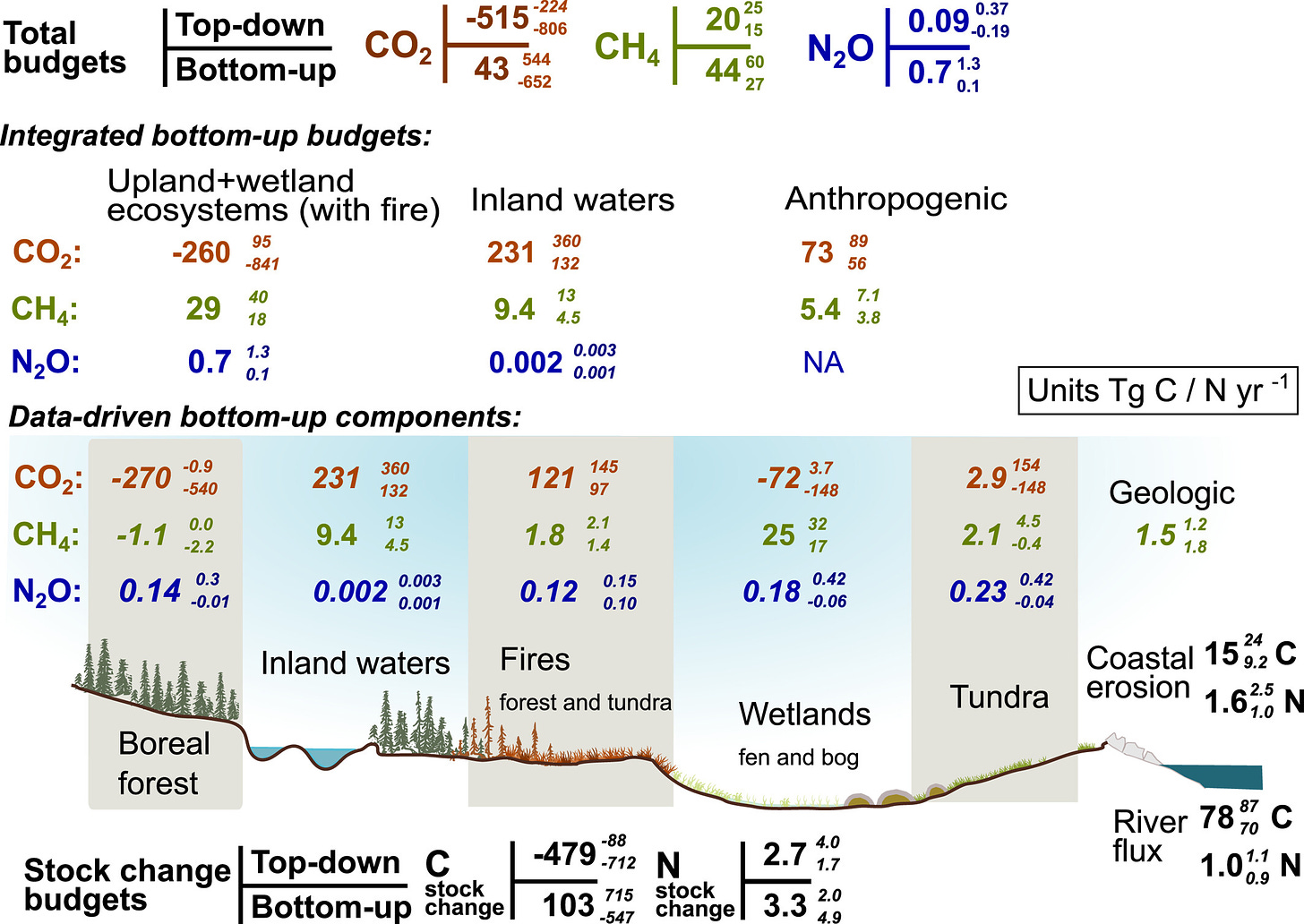
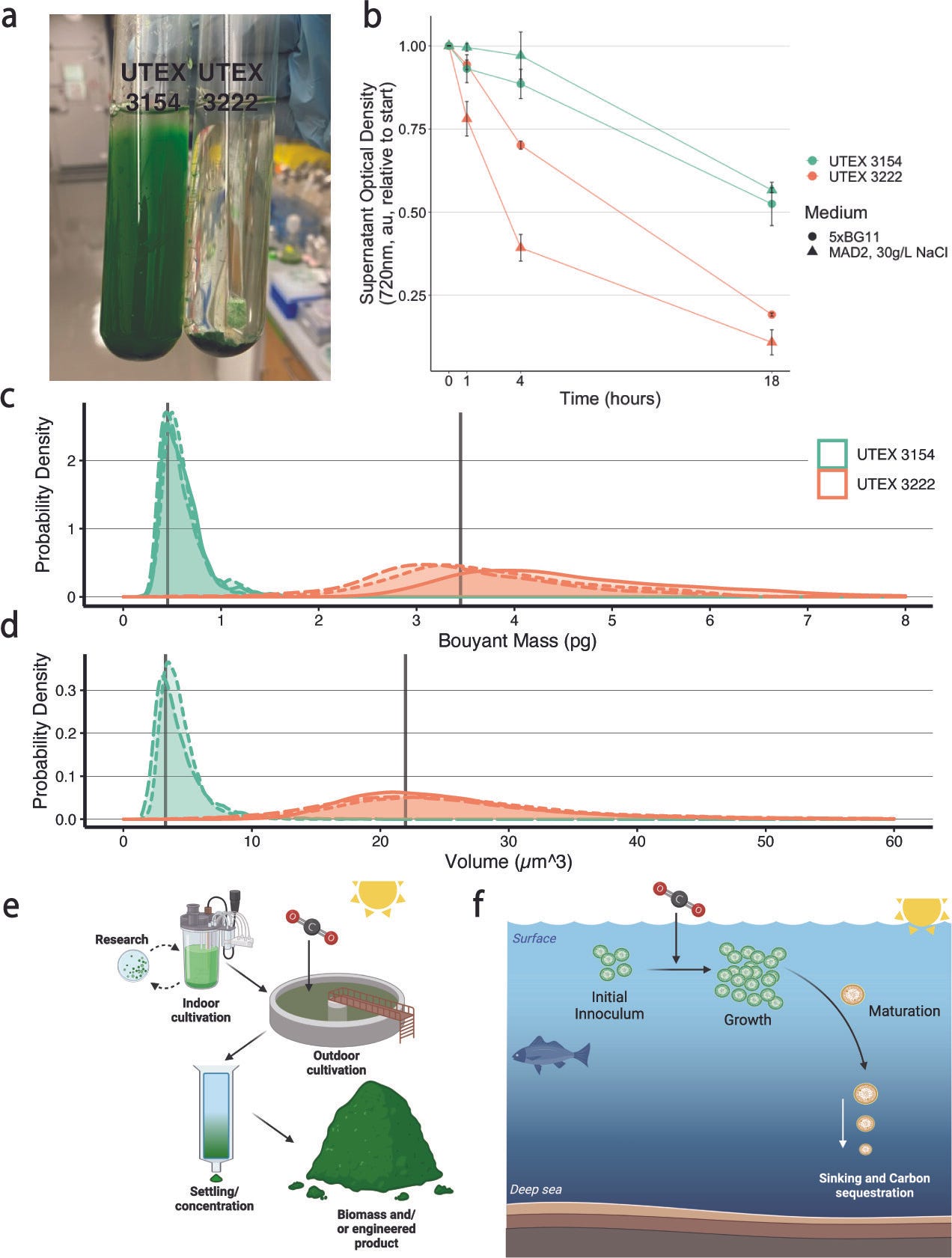
WEB POSTS
Scientists say the slime in your dishwasher could unlock a solution to global warming (CNN)
Introducing a new tool for monitoring, reporting and verifying CO2 removals (GRI & AlliedOffsets)
Plan for 30,000-tree nature reserve backed (BBC)
Global fleet of undersea robots reveals the phytoplankton hidden beneath the ocean's surface (Dalhousie University)
Gentoo.earth founder Juliet Kirby is building an AI-powered ‘Bloomberg for climate intelligence’ (Smart Company)
Cold effect: Tech that can remove carbon dioxide from the atmosphere in even the chilliest climates (Toronto Star)
How US States Can Lead on Carbon Removal Policy (World Resources Institute)
The great carbon clear-up (Founders Factory)
The Charm Underground - October 2024 (Charm Industrial)
Microsoft builds first datacenters with wood to slash carbon emissions (Microsoft)
Mission Zero announces first US patent as it begins deployment of third DAC plant (Mission Zero)
The Rise of CDR Consortiums: How Frontier, Milkywire, and NextGen can Reshape CDR market (AlliedOffsets)
Increasing cashflow for suppliers (Isometric)
Now is the time to provide evidence to inform IPCC carbon removal reporting standards carbon(plan)
What's happening in our greenhouse-A short update on what's going on at the largest greenhouse experiment for EW (Carbon Drawdown Initiative)
REPORTS
Carbon Dioxide Removal: Counting the Cost (Resource Wise)
Building Up Buyer Demand for Novel Carbon Dioxide Removal Technologies (Bipartisan Policy Center)
Global Carbon Dioxide Removal (CDR) Market Valuation Expected to Reach $2.11 Billion by 2032 (FNM)
Marine Carbon Dioxide Removal (mCDR), Canada’s Missing Climate Strategy (University of Waterloo)
Primer on Carbon Dioxide Removal Credits (ENERGY)
Towards Net Zero Emissions –Creating Incentives for BECCS and DACCS (European Liberal Forum)
2024 Annual Report Highlights Progress Towards Evaluating OAE as Potential Climate Solution (Carbon to Sea Initiative)
The Role of Carbon Removals in Decarbonising Aviation (SimpliFlying)
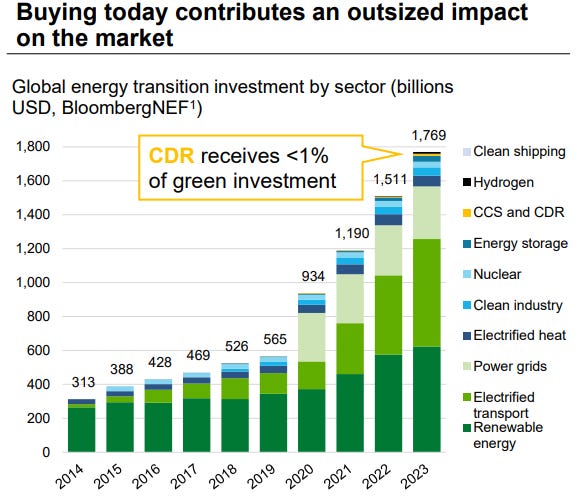
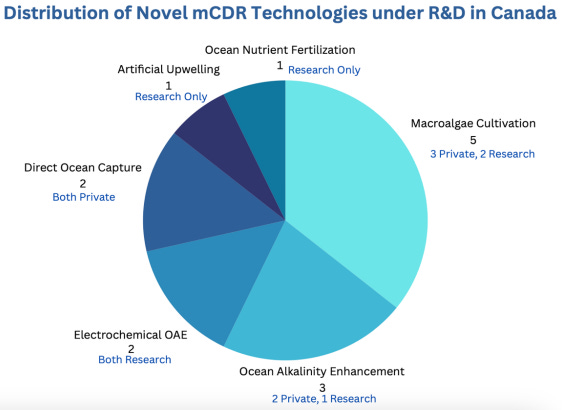
BOOK
Removing carbon dioxide from the atmosphere (GERICS)
UPCOMING EVENT
(NEW) Women+ AirMiners Virtual Networking by AirMiners | 05 November 2024 | Online
Scaling the CDR market to enable global net-zero by Milkywire | 05 November 2024 | Online
Defining Biochar Quality—Essential insights for an impact-driven carbon removal strategy by Supercritical | 05 November 2024 | Online
Carbon Dioxide Removal (CDR) Markets: Innovation Underground Series by Enverus | 05 November 2024 | Online
(NEW) A Buyer's Guide to CDR by Isometric | 06 November 2024 | Online
(NEW) The role of carbon credit portfolios in a high integrity market by BeZero Carbon | 07 November 2024 | Online
Can we engineer our oceans to help deliver a safe, stable climate? by Oxford Earth Sciences | 08 November 2024 | London, UK
(NEW) Plan Sea: The Potential Role of Marine-based Carbon Dioxide Removal for Combatting Climate Change by School at Complex Adaptive Systems ASU | 08 November 2024 | Online & In-person (Arizona State University)
(NEW) Catalyzing carbon removal through public-private partnerships by Climeworks at COP29 | 12 November 2024 | Baku
Workshop with focus on Enhanced Weathering by CSink | 12 November 2024 | Online & In-person (Belgium)
How Technology Can Help Strengthen Carbon Removal Accountability in the Global South by Carbon Business Council, Climate Collective | 13 November 2024 | Online
Building Europe's next Carbon Valley: The future of Carbon Removal in Switzerland and beyond by Women in Carbon, Google, Swiss Cleantech and Carbon Removal Partners | 13 November 2024 | Zurich
(NEW) Supplier Spotlight: InPlanet Enhanced Rock Weathering by Klimate | 13 November 2024 | Online
(NEW) Garden Grants Webinar: Greenhouse Gas Removal by Homeworld Collective | 13 November 2024 | Online
(NEW) Carbon Removals and the SBTi: Exploring New Pathways for Net-Zero by Senken | 13 November 2024 | Online
Biochar application and enhanced weathering for increasing soil carbon storage: the story never ends? | 14 November 2024 | University of Antwerp
(NEW) NYCDR Happy Hour: Special Edition with C2V's Year 4 Cohort and Urban Future Lab Community by Urban Future Lab, Carbon Business Council | 14 November 2024 | New York
(NEW) CDR Innovation & Impact 2024 by Aliénor von Roten, Oliver Akeret | 14 November 2024 | Zurich
(NEW) Roads to Removal Wyoming by LLNL | 14-15 November 2024 | Laramie, Wyoming
How to apply biochar in sustainability management and accounting | German Biochar Forum | 18 November 2024
Exploring the Ethics and Societal Interactions of Climate Intervention by the U.S. National Science Foundation
Integrative synthesis workshop focusing on identifying gaps in current governance & ethics | 18 November 2024 | Online
Fourth Annual Carbon Dioxide Removal Law & Policy Conference by Institute for Responsible Carbon Removal at American Univ. and Environmental Policy and Culture Program at Northwestern University | 18 November 2024 | Online
Puro.earth "Carbon Dioxide Removal: Commercialisation Landscape" Panel at Slush 2024 | 19 November 2024 | Finland
The Road to Net Zero: How to Pave the Way for Carbon Farming, Removal, and Capture by Landmark | 28 November 2024 | House of the Dutch Provinces
Industrial Energy Green Transition 2024 | 3-5 December 2024 | Tokyo
Carbon Removal Tech & CDR Markets | 05 December 2024 | Tokyo, Japan
Scoping Workshop: Leaky deltas: sources or sinks in the global carbon cycle? by OCB | 17-20 March 2025 | Baton Rouge, LA
Ocean Visions Biennial Summit 2025 | 25-27 March 2025 | British Columbia
Bio-Char IV Conference | May 18-23, 2025 | Santa Marta, Colombia
ERW25: Terrestrial and marine carbon dioxide removal by enhanced rock weathering by University of Antwerp | 3-5 June 2025 | Belgium
Carbon Clean-up Camp | 25 June 2025
We have curated a “Carbon Removal Events Calendar.” Explore and stay informed about upcoming events, conferences, and webinars on Carbon Dioxide Removal technology. Sync specific events / all events to your default calendar to ensure you never miss out on important CDR updates.
GUIDELINES:
Sync selected events to your default calendar in these simple steps:
1) Click on the event you want to sync.
2) Tap the menu icon (three vertical lines) at the top left.
3) Choose 'Share.'
4) Pick your default calendar.
5) Save the event.
Sync the entire Teamup Calendar to your default calendar with these simple steps:
1) Tap the menu icon (three vertical lines) at the top right.
2) Choose 'Preferences.'
3) Click 'iCalendar Feeds.'
4) Copy the URL shown for 'CDR Events / CDR General Guidelines / CDR Job Deadlines.'’
5) Paste the URL into your default calendar settings.
6) Click 'Subscribe' or 'Add Calendar.'
For more detailed instructions, visit: https://calendar.teamup.com/kb/subscribe-to-teamup-icalendar-feeds/
You can directly sync all Carbon Removal events to your default calendars by pressing the link below:
JOB OPPORTUNITIES
Research Coordinator, Carbon Dioxide Removal Research at University of Calgary | Calgary, Alberta, Canada
"The CanCO2Re Initiative is seeking a Research Coordinator for Carbon Dioxide Removal (CDR) who can support delivery of our transdisciplinary research program, represent the project to external stakeholders and identify opportunities to grow the initiative, and develop their own scholarship in the area of CDR. Reporting to the Principal Investigator this role will be expected to collaborate with internal experts across a range of disciplines and make connections with external experts in industry and government."
Fully Funded MSc by Research Scholarship: Maximising carbon sequestration and storage within an urban university campus setting at Swansea University | Deadline to apply: 11 November 2024
“University campuses, as microcosms of urban environments, offer unique opportunities for enhancing carbon sequestration and storage through intentional management and design. This study aims to assess the current status of soil carbon and carbon fluxes within landscapes on a university campus (such as grasslands and woodlands) and compare it with other natural settings. The effects of management (e.g. mowing frequency) will also be quantified. The goal is to provide actionable recommendations for the campus sustainability team to enhance ecological value and sustainability, alongside maximising carbon sequestration potential. This study will contribute to the UN Sustainable Development Goals, SDG3 (Good Health and Wellbeing), SDG7 (Affordable and Clean Energy), SDG13 (Climate Action) and SDG15 (Life on Land). This research builds on these findings, focusing on the unique context of an urban university campus.”
Program Director, Methane Removal at Spark Climate Solution | Remote
"Spark’s first programs focus on large, under-addressed methane-related areas that currently represent unmanaged risks to our overall climate trajectory, including work on enteric methane mitigation, methane removal research, natural systems feedbacks, and additional innovation areas to assist efforts to mitigate climate super pollutants."
R&D engineer at SeaO2 | Netherland
"SeaO2 is a Dutch Ocean Carbon Removal company committed to addressing climate change through removing CO2 from the atmosphere at gigaton-scale, harnessing the potential of the oceans."
Mechanical Engineer at Captura | Pasadena, California, United States
"By studying the planet’s natural cycles, Captura designed a solution that removes CO2 from the ocean and harnesses its ability to heal the climate—a process known as Direct Ocean Capture."
Head of sales - Carbon Removal at CRYSTALTRADE | Ville de Paris, Île-de-France, France
"CrystalTrade is an innovative French company specializing in the carbon removal market , a fast-growing and rapidly structuring sector. We support biochar projects, a sustainable technology that captures CO₂ for long-term storage, ensuring complete and reliable traceability thanks to our dMRV (digital Monitoring, Reporting, Verification) software."
Head of Carbon Management at CO280 | Canada
"CO280 is a leading developer of large-scale carbon removal projects that will remove more than 10 megatons of carbon per year from the atmosphere. We are achieving this by partnering with pulp and paper companies to capture biogenic CO2 from pulp mills and store it permanently in geologic formations."
Process Engineer at Bio-Logical | Thika, Kiambu, Kenya
"Bio-Logical develops nature-based carbon removal projects that support the world's most climate-vulnerable communities to improve their climate resilience and livelihoods."
Test Engineering Manager at CarbonCapture | Arts District, Los Angeles, CA
"CarbonCapture Inc. develops and deploys direct air capture (DAC) machines that can be connected in large arrays to remove massive amounts of carbon dioxide from the atmosphere. With a patented modular open systems architecture, our DAC platform allows for plug-and-play upgrades, mass production, unlimited scalability, and rapid technology iterations."
Carbon Removal Scientist, Biomass Feedstock Accounting at Isometric | New York City, London
"Isometric is the world’s most trusted carbon registry. We issue scientifically rigorous carbon credits to help Fortune 100 companies avoid greenwashing while tackling climate change."
Director Sales at GoodCarbon | Berlin
"At goodcarbon, we aim to shift the focus of global capital towards conserving and restoring ecosystems. We enable companies to deliver on their net-zero and nature-positive pledges confidently through high-quality carbon credits. Simultaneously, we assist developers of Nature-based Solutions projects globally in accessing funding."
Regional Sourcing Lead - Carbon Removal Technologies, North America & Europe at Climate Impact Partners | London & Remote
"Climate Impact Partners is a leading provider of high-quality climate solutions, dedicated to ensuring a thriving future for all life on earth. We are currently seeking a Regional Sourcing Lead in our Global Supply Chain team, to leverage relationships with climate project partners to secure supply of high-quality carbon credits for our corporate clients."
Executive Assistant & University Liaison/Science Facility Management at CarbonRun | Halifax, Nova Scotia, Canada
"CarbonRun is a Nova Scotian company dedicated to addressing the global climate crisis and restoring freshwater ecosystems. Our mission is to combat climate change, restore aquatic ecosystems, and strengthen communities."
Senior Mechanical Engineer, Prototype at Heirloom | Brisbane, CA
"At Heirloom, we are turning that into reality. We use the natural carbon capture properties of abundant minerals to pull CO2 from the air, and store it permanently underground. We come to work every day to slow climate change, and are united behind a single, common goal - to remove 1 billion tons of CO2 from the sky by 2035, and to not stop before we get there."
Senior Technical Recruiter at Brimstone | Oakland, CA
"Brimstone developed a breakthrough process to decarbonize cement production, one of the leading drivers of climate change."
Piping Mechanical Equipment Engineer at Paebbl | The Netherlands
"Paebbl mission is to permanently sequester CO2 and repurpose it into essential products. Inspired by natural CO2 mineralization, our technology accelerates this process by a factor of a million and is now ready for scale-up."
Chief Of Staff at Varaha | Gurugram, Haryana, India
"Varaha is a leading climate tech venture focused on nature-based solutions such as regenerative agriculture, ARR, and biochar projects that support smallholder land stewards at scale."
Financial Controller at VaultedDeep | Houston, TX · San Francisco, CA
"Vaulted is an emerging leader in permanent carbon removal. As a Biomass Carbon Removal and Storage (BiCRS) solution, Vaulted delivers permanent, high quality carbon removal at scale through the geologic sequestration of carbon-filled organic waste."
Millwright at Carbon Engineering | Squamish, BC, Canada
"Carbon Engineering is a team of innovators from around the globe with a shared mission and commitment of advancing large-scale Direct Air Capture technology."
Senior Mechanical Engineer - Sensor Systems at Everest Carbon | Linz, Austria
"Everest Carbon is a fast-growing, VC-backed climate technology startup specializing in innovative sensor technology for the commercialization of negative emissions."
Project Manager - Contractor at EbbCarbon | South San Francisco, CA
"Ebb Carbon is a climate and ocean-health restoration company. Our mission is to remove gigatons of CO2 from the air, while reducing ocean acidification to restore a healthier planet for generations to come. We remove carbon dioxide from the air by accelerating the ocean’s natural ability to capture and durably store carbon dioxide. Our electrochemical approach reduces ocean acidity and has the potential to be one of the largest scale and lowest cost approaches to removing excess CO2."
Industrial Mechanic at Phlair | Munchen
"Phlair unleash CO2's potential through breakthrough innovation. We rapidly deploy Direct Air Capture technology, facilitating the removal and reuse of CO2 at scale."
Looking for your dream job in CDR? There are 737 jobs available *right now*: check them all out at:
PODCASTS
Episode 7: 'Got Wood? | Grounded: A Climate Startup Journey
"After months of physical and emotional labour, the stars are beginning to align and the prospect of actually making biochar is now tantalisingly close. But Tom’s recipe is still missing one crucial ingredient: wood, and lots of it. So, while he pores over his cashflow projections and awaits delivery of his machine, he sets about trying to find some. And as he soon discovers, this wood business is a little trickier than it first appears. For instance, how many Toms does it take to guide an 8-wheeler down a country road? If a tree falls in a forest, does it necessarily make good biochar? And what does this all have to do with elephants?
Grounded is the award-winning story of a startup that wants to remove carbon from the atmosphere and help reshape our relationship with the planet. Ideally without burning to the ground in the process."
The unexplored frontier of methane removal | Catalyst with Shayle Kann
"We capture concentrated methane emissions from point sources like dairy barns, landfills, and coal mines. Mitigating methane emissions is essential to hitting net-zero targets, but could we capture diluted gasses straight from the atmosphere, too?
In this episode, Shayle talks to Dr. Gabrielle Dreyfus, Chief Scientist at the Institute For Governance & Sustainable Development, about a National Academy of Sciences report on the unexplored area of methane removal. Gabrielle chaired the committee behind the report. Shayle and Gabrielle cover topics like:
-Why methane removal may be critical to addressing methane from hard-to-abate sources, like enteric emissions and tropical wetlands
-Key differences between methane removal and carbon dioxide removal
How reducing methane in the atmosphere may also reduce its atmospheric lifetime
-Technological pathways, including reactors, concentrators, surface treatments, ecosystem uptake enhancement, and atmospheric oxidation enhancement
-The potential for combining methane and carbon dioxide removal in direct air capture"
Breaking down the complicated business of carbon capture | Climate Conversations
"Carbon dioxide is responsible for 76 per cent of total greenhouse gas emissions. And yet, the potential to lock up harmful emissions is big business. Jack Board speaks to a world leader in this space, the CEO of Climeworks Christoph Gebald."
Hourglass Climate’s Founder & Executive Director Grace Andrews | Plan Sea Podcast
"In today's episode, hosts Anna Madlener and Wil Burns are joined by Grace Andrews from Hourglass Climate. They discuss Hourglass' work on environmental monitoring and carbon removal quantification, as it leads measurement, reporting, and verification (MRV) for a significant ocean alkalinity enhancement (OAE) field trial."
YOUTUBE VIDEOS
Insights into Monitoring, Reporting and Verification Costs for CDR | Institute for Responsible Carbon Removal
"Monitoring, reporting and verification (MRV) is a central component of the governance architecture for carbon dioxide removal (CDR). Collecting detailed and accurate information on the cost of MRV for CDR is a challenge. Little information is publicly available, and companies find it difficult to share what information they have, because it is either commercially sensitive, unknown or difficult to disaggregate into constituent parts. In this webinar, the panelists will discuss the findings from their forthcoming publication 'Towards improved cost estimates for monitoring, reporting and verification of carbon dioxide removal', including novel insights into the absolute and relative cost of MRV across the spectrum of novel and conventional CDR methods, the extent to which the cost of MRV is perceived as a barrier to scaling, where opportunities lie to reduce the cost of MRV and how to get comfortable with MRV uncertainty. Implications for policymakers and CDR companies will also be discussed."
Let's go to COP29! | Tito - AirMiners
Catalyzing CDR Innovation: How XPrize Projects Will Scale | Flowcarbon
"Meet four finalists from the global Xprize competition, showing casing the best and most innovative carbon removal technologies. This panel will explore models for funding early-stage CDR projects, and examine how targeted investments are shaping the future of carbon removal technologies."
The Rising Significance of Carbon Removal in the Carbon Markets | Flowcarbon
"Dive into the practical realities of turning corporate net zero commitments into actionable plans. This panel will examine innovative financing mechanisms, implementation challenges, and best practices for companies transitioning from climate pledges to tangible emissions reduction and removal strategies. Learn how leading corporations are navigating — and investing in — this complex journey."
How Governments Can Ensure Trust and Transparency in Carbon Removal | Carbonfuture
"The carbon removal industry is growing, with investments in emerging technologies and projects increasing over the past few years. More tonnes of CDR have been purchased this year compared to previous years (according to CDR.fyi), but there is still a long way to go to meet the demand needed for net-zero targets.
With many of these purchases scheduled to be delivered over the coming years, and as we draw closer to many corporate buyers’ public net-zero deadlines, issues of trust and transparency are at a critical juncture. So what is being done at the governmental level right now to ensure the integrity of this quickly scaling industry?
In this webinar, our panel discuss the steps being taken in the United States and the European Union to build trust and transparency in the carbon removal market. They covered current policy developments and explore dthese key questions:
-What do governments believe will be necessary for scaling CDR now and into the future?
-What is the role of digital monitoring, reporting and verification (dMRV) in policymaking and planning?
-What role does the private sector have in assisting policymakers in building integrity in carbon removal?
-What are the differences in the American and European approach to ensuring trust in carbon markets?"
What's next for the Voluntary Carbon Market | AirMiners
"Our AirMiners community is keenly interested in the state of voluntary carbon markets, where carbon removal credit sales are the lifeblood of a generation of CDR startups.Join us with panelists Dr. Jennifer Jenkins of Rubicon Carbon, and Robert Höglund of Milkywire at 5pm Pacific on Thursday October 3rd - Carbon Removal Day!We'll cover what the future could hold for carbon removal credits, SBTi, Core Carbon Principles, and much much more!"
Rethinking Carbon with Rob Palmer and UNDO Carbon | Anturus Education
"Join us as we talk with Rob Palmer, Director of Innovation at Undo Carbon, about the revolutionary technology of enhanced rock weathering. Discover how this method not only removes CO2 from the atmosphere but also benefits agriculture. Rob explains the difference between carbon capture and carbon removal, the challenges of scaling, and the science behind this climate solution. Perfect for anyone interested in innovative ways to tackle the climate crisis."
Holocene CEO on it's advancing the energy transition for businesses, utilities, and communities | New York Stock Exchange
"Holocene is a clean energy company focused on the development, construction, and operation of renewable energy projects, particularly in solar power. The company aims to advance the transition to clean energy by providing sustainable energy solutions for businesses, utilities, and communities. Holocene works on large-scale solar installations, often partnering with clients to help them reduce their carbon footprint and achieve their renewable energy goals. Their mission is to accelerate the shift toward a low-carbon future through innovative, scalable clean energy solutions."
Biochar Demonstrator | CO₂RE - The Greenhouse Gas Removal Hub
Epiphyte Weekly Stream: Opensource Direct Air Capture | OpenAir
"A weekly get together of the OpenAir community during which members plan and problem solve for the next Epiphyte build at University of Texas - Austin."
About the CO2RE Hub | CO₂RE - The Greenhouse Gas Removal Hub
"Introducing the CO2RE Hub, the UK’s national research hub on Greenhouse Gas Removal (GGR). Together, CO2RE and the Demonstrators form the UKRI Greenhouse Gas Removal Demonstrators (GGR-D) Programme. CO2RE is responsible for co-ordinating the GGR-D Programme and undertaking solutions-led research on GGR."
Policy workshop on international carbon certification schemes - Brussels, 26 September 2024 | 4p1000 Initiative
"This workshop will give you an insight into what is happening in the United States and Australia and an overview of the context in the Pacific region and Europe.Organised by the ORCaSa project in the framework of the Soil Carbon International Research Consortium (IRC), this event is an opportunity for experts and policymakers to meet, exchange ideas, and make progress in the field of soil carbon policy.Moreover, the results of this workshop will be used to draw up a policy brief. Indeed, to achieve the objectives of the Paris Agreement on climate neutrality, to support the EU Green Deal and the objectives of the EU Soil Mission, Europe must coordinate its research and innovation efforts on soil carbon with international stakeholders and policymakers."









